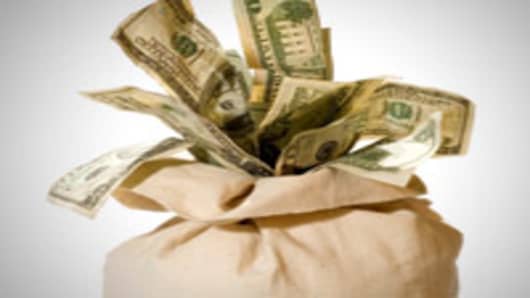A lot of downward pressure on the dollar is easing off. Here's why — and what you should do.
Yes, today's GDP numberwas disappointing, and yes, so were the jobless claims. But increasingly, signs point to the end of dollar doldrums .
First up, of course, is the end of QE2, which is finally within sight. All those low interest rates have been good for stocks, but they have been bruising the dollar, partly by boosting investors' appetite for riskier, and higher-yielding, currencies.
"If this market perceives the end of QE2 as a risk-off event, that would probably have more of an effect than interest rates on the direction of the dollar going forward," says Alan Ruskin, global head of G10 FX strategy at Deutsche Bank. "The end of QE2 would be less of a headwind than the end of a tailwind for global risk appetite," and it would "demarcate a choppier risk and less USD negative environment."
Big investors are also displaying less bearishness on the dollar. Data from the Chicago Mercantile Exchange for the week ending May 17 shows a big drop in dollar short positions among hedge funds — down $8 billion to $25.5 billion. That pretty much has to help the currency.
But wait — there is more. The effective federal funds rate, which determines the rate at which banks will lend to each other overnight, has been falling. There are various technical reasons behind the drop, but the result has been excess reserves at the Fed, which according to analysts at Barclays Capital, has put downward pressure on short-term interest rates — with predictable results for the dollar.
"We think that the sharp fall in US short-term rates along with the FOMC's stubbornly dovish stance was behind the USD weakness in April," they wrote in a research note.
Earlier this week, however, the Fed announced that it would allow government-supported entities like Fannie Mae and Freddie Mac to borrow Treasurys from the Fed when the time comes to withdraw cash from the financial system. Details are still being worked out, but the analysts at Barclays believe this could lead to higher fed funds rates — and thus less downward pressure on interest rates and the dollar.
"Decreases in excess reserves at the Fed have tended to be associated with USD appreciation since late 2008," though somewhat less so in the past year, the Barclays analysts wrote. "The move in effective fed funds rate tends to lead the move in 3M US LIBOR one of the key drivers of USD, according to our analysis."
OK, Fed policy can be hard to follow. But the bottom line is simple: between QE2, hedge fund sentiment, and some technical changes in Fed policy, the downward pressure on the dollar is decidedly easing.
Tune In: CNBC's "Money in Motion Currency Trading" airs on Fridays at 5:30pm.
"Money in Motion Currency Trading" repeats on Saturdays at 7pm.



